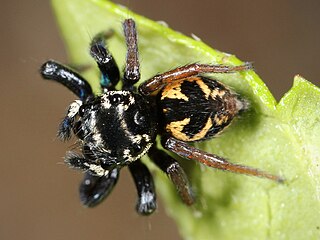Aillutticus is a genus of South American jumping spiders that was first described by María Elena Galiano in 1987.

Beata is a genus of jumping spiders that was first described by George Peckham & Elizabeth Peckham in 1895.

Breda is a genus of jumping spiders that was first described by George Peckham & Elizabeth Peckham in 1894.
Capeta is a genus of spiders in the family Salticidae.

Corythalia is a genus of jumping spiders that was first described by Carl Ludwig Koch in 1850. The genus is distributed throughout most of the Western Hemisphere. Species of this genus are found in The Americas.
Kalcerrytus is a genus of spiders in the jumping spider family, Salticidae.

Noegus is a genus of jumping spiders that was first described by Eugène Louis Simon in 1900.

Pachomius is a genus of jumping spiders that was first described by George and Elizabeth Peckham in 1896. Uspachia was merged into genus Romitia in 2007, and all nine species were merged into Pachomius in 2015. The name is derived from Pachomius, the founder of cenobitic monasticism.

Sassacus is a genus of jumping spiders that was first described by George and Elizabeth Peckham in 1895. It is likely named after Sassacus, a Native American chief of the 16th and 17th century.

Thiodina is a genus of jumping spiders that was first described by Eugène Louis Simon in 1900.

Thyene is a genus of jumping spiders that was first described by Eugène Louis Simon in 1885. It is a junior synonym of Mithion, and senior synonym of Brancus, Paramodunda and Gangus.
Titanattus is a genus of jumping spiders that was first described by George and Elizabeth Peckham in 1885. The name is a combination of "Titan" and the common salticid suffix -attus. It was merged with Agelista in 2017.

Zygoballus is a genus of jumping spiders found in North and South America.

Simonellini is a tribe of spiders belonging to the Amycoida clade of the subfamily Salticinae of the family Salticidae. The group has been treated at a variety of formal and informal ranks, with different circumscriptions, including as the subfamilies Synemosyninae and Simonellinae. Its species mimic ants and beetles.

Colonus is a genus of spiders in the jumping spider family, Salticidae. Colonus species are endemic to North and South America, ranging from New York to Argentina. All members of the genus have two pairs of bulbous spines on the ventral side of the first tibiae. The function of these spines is unknown. Colonus was declared a junior synonym of Thiodina by Eugène Simon in 1903, but this was reversed by Bustamante, Maddison, and Ruiz in 2015.
Stenoterommata is a genus of South American araneomorph spiders in the family Pycnothelidae. It was first described by E. L. Holmberg in 1881. Originally placed with the Ctenizidae, it was transferred to the funnel-web trapdoor spiders in 1985, then to the Pycnothelidae in 2020. It is a senior synonym of Ctenochelus.
Nigorella manica is a species of spider in the family Salticidae, found in Zimbabwe.
Hermosa is a genus of jumping spiders first described by G. W. Peckham and E. G. Peckham in 1892, and synonymized with Myrmarachne in 1901. In 2016, Jerzy Prószyński split up Myrmarachne, creating nine new genera, all with names beginning "Myrm". However, it turned out that Myrmavola volatilis, the type species of Myrmavola, was also the type species of Hermosa, and Myrmavola was made a junior synonym. It is part of the Myrmarachnini tribe within the Salticoida clade of Salticinae.

The Sitticini are a tribe of spiders in the family Salticidae. The tribe has been divided into two subtribes, Aillutticina, with five Neotropical genera, and Sitticina, with five genera from Eurasia and the Americas. One genus is unplaced within the tribe. The taxonomy of the tribe has been subject to considerable uncertainty. It was clarified in 2020.











